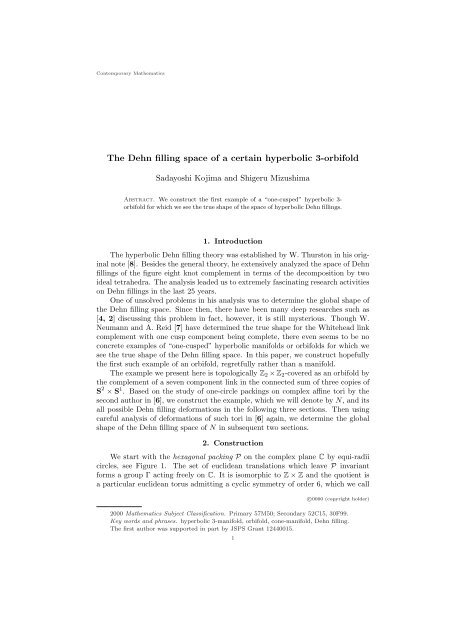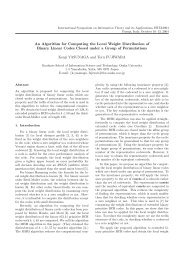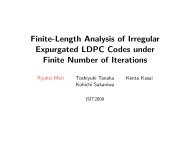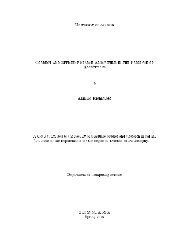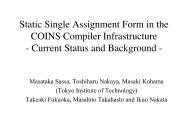The Dehn filling space of a certain hyperbolic 3-orbifold
The Dehn filling space of a certain hyperbolic 3-orbifold
The Dehn filling space of a certain hyperbolic 3-orbifold
You also want an ePaper? Increase the reach of your titles
YUMPU automatically turns print PDFs into web optimized ePapers that Google loves.
Contemporary Mathematics<strong>The</strong> <strong>Dehn</strong> <strong>filling</strong> <strong>space</strong> <strong>of</strong> a <strong>certain</strong> <strong>hyperbolic</strong> 3-<strong>orbifold</strong>Sadayoshi Kojima and Shigeru MizushimaAbstract. We construct the first example <strong>of</strong> a “one-cusped” <strong>hyperbolic</strong> 3-<strong>orbifold</strong> for which we see the true shape <strong>of</strong> the <strong>space</strong> <strong>of</strong> <strong>hyperbolic</strong> <strong>Dehn</strong> <strong>filling</strong>s.1. Introduction<strong>The</strong> <strong>hyperbolic</strong> <strong>Dehn</strong> <strong>filling</strong> theory was established by W. Thurston in his originalnote [8]. Besides the general theory, he extensively analyzed the <strong>space</strong> <strong>of</strong> <strong>Dehn</strong><strong>filling</strong>s <strong>of</strong> the figure eight knot complement in terms <strong>of</strong> the decomposition by twoideal tetrahedra. <strong>The</strong> analysis leaded us to extremely fascinating research activitieson <strong>Dehn</strong> <strong>filling</strong>s in the last 25 years.One <strong>of</strong> unsolved problems in his analysis was to determine the global shape <strong>of</strong>the <strong>Dehn</strong> <strong>filling</strong> <strong>space</strong>. Since then, there have been many deep researches such as[4, 2] discussing this problem in fact, however, it is still mysterious. Though W.Neumann and A. Reid [7] have determined the true shape for the Whitehead linkcomplement with one cusp component being complete, there even seems to be noconcrete examples <strong>of</strong> “one-cusped” <strong>hyperbolic</strong> manifolds or <strong>orbifold</strong>s for which wesee the true shape <strong>of</strong> the <strong>Dehn</strong> <strong>filling</strong> <strong>space</strong>. In this paper, we construct hopefullythe first such example <strong>of</strong> an <strong>orbifold</strong>, regretfully rather than a manifold.<strong>The</strong> example we present here is topologically Z 2 × Z 2 -covered as an <strong>orbifold</strong> bythe complement <strong>of</strong> a seven component link in the connected sum <strong>of</strong> three copies <strong>of</strong>S 2 × S 1 . Based on the study <strong>of</strong> one-circle packings on complex affine tori by thesecond author in [6], we construct the example, which we will denote by N, and itsall possible <strong>Dehn</strong> <strong>filling</strong> deformations in the following three sections. <strong>The</strong>n usingcareful analysis <strong>of</strong> deformations <strong>of</strong> such tori in [6] again, we determine the globalshape <strong>of</strong> the <strong>Dehn</strong> <strong>filling</strong> <strong>space</strong> <strong>of</strong> N in subsequent two sections.2. ConstructionWe start with the hexagonal packing P on the complex plane C by equi-radiicircles, see Figure 1. <strong>The</strong> set <strong>of</strong> euclidean translations which leave P invariantforms a group Γ acting freely on C. It is isomorphic to Z × Z and the quotient isa particular euclidean torus admitting a cyclic symmetry <strong>of</strong> order 6, which we callc⃝0000 (copyright holder)2000 Mathematics Subject Classification. Primary 57M50; Secondary 52C15, 30F99.Key words and phrases. <strong>hyperbolic</strong> 3-manifold, <strong>orbifold</strong>, cone-manifold, <strong>Dehn</strong> <strong>filling</strong>.<strong>The</strong> first author was supported in part by JSPS Grant 12440015.1
2 SADAYOSHI KOJIMA AND SHIGERU MIZUSHIMAthe hexagonal torus. P then descends to what we call a one-circle packing on thehexagonal torus.Figure 1. Hexagonal packingLet us regard the complex plane C as the boundary <strong>of</strong> the upper half <strong>space</strong>model H 3 <strong>of</strong> the <strong>hyperbolic</strong> 3-<strong>space</strong>. P together with the dual packing P ∗ whichconsists <strong>of</strong> circumscribed circles <strong>of</strong> interstices in P fills C. Each member <strong>of</strong> both Pand P ∗ bounds a hemisphere in H 3 and such a hemisphere bounds a hemiball facingC. Cutting <strong>of</strong>f those hemiballs from H 3 , we obtain a region L with ideal polygonalboundary in H 3 . <strong>The</strong> intersections <strong>of</strong> P and P ∗ correspond to ideal vertices <strong>of</strong> Lwith rectangular section.<strong>The</strong> group Γ acts properly discontinuously on H 3 by the Poincaré extensionsand the region L is invariant under the action. Hence taking quotient, we obtain a<strong>hyperbolic</strong> 3-manifold N with ideal polygonal boundary and a cusp. <strong>The</strong> polygonalboundary consists <strong>of</strong> two ideal triangles and one ideal hexagon, where they intersectorthogonally.Take the double <strong>of</strong> N along triangular faces, and then take again the double<strong>of</strong> the result along the boundary which now consists <strong>of</strong> two ideal hexagons. Thisdouble doubling construction gives us a <strong>hyperbolic</strong> 3-manifold M with seven cuspsamong which 4 are old and 3 new. It is obvious by the construction that M admitsa Z 2 × Z 2 -symmetry generated by two reflections associated with the doubling. Nis the quotient <strong>of</strong> M by this symmetry and therefore we regard N as an <strong>orbifold</strong>from now on, and study its <strong>Dehn</strong> <strong>filling</strong> deformations as an <strong>orbifold</strong>.Topologically N is a solid torus with a core loop and three points on the boundaryremoved. To see the effect on the first double, stretch the removed vertices on∂N to arcs appropriately so that they become circles after doubling. <strong>The</strong>n by firstdoubling, we obtain a genus 3 handle body with two core loops and three loopson the boundary removed. This is depicted in Figure 2, where the shaded disksrepresent triangular faces along which we took the double.A framed link representation <strong>of</strong> M, the double <strong>of</strong> Figure 2, can be immediatelydescribed by Figure 3.3. Circle Packings on Complex Affine ToriWe will construct <strong>Dehn</strong> <strong>filling</strong> deformations <strong>of</strong> N using deformations <strong>of</strong> thehexagonal packing on C with the same combinatorial type. <strong>The</strong> hexagonal packingdescends to a one-circle packing on the hexagonal torus. Conversely, the universalcover <strong>of</strong> a one-circle packing on the torus combinatorially equivalent to one on thehexagonal torus is a packing on the plane equivalent to the hexagonal packing.
THE DEHN FILLING SPACE OF A CERTAIN HYPERBOLIC 3-ORBIFOLD 3¤¡¤ £¡£¤¡¤ £¡£¤¡¤ £¡£¤¡¤ £¡£¤¡¤ £¡£¤¡¤ £¡£¤¡¤ £¡£¤¡¤ £¡£¢¡¢ ¡¢¡¢ ¡¢¡¢ ¡¢¡¢ ¡¢¡¢ ¡¢¡¢ ¡¢¡¢ ¡¢¡¢ ¡Figure 2. First double0 0 0Figure 3. Framed link representation <strong>of</strong> MHowever since the hexagonal packing is rigid in euclidean geometry, there are noother one-circle packings on euclidean tori than one on the hexagonal torus. Henceto get deformations, we will work with one-circle packings not on euclidean butrather on complex affine tori. This section is to review what has been known aboutcomplex affine tori and circle packings on them according to [3, 6].A complex affine structure on the torus is by definition a collection <strong>of</strong> localcharts on C whose transition function is a restriction <strong>of</strong> a complex affine transformation,so in particular it defines a complex structure. <strong>The</strong> uniformization assigningthe conformal class to each affine torus defines a map <strong>of</strong> the <strong>space</strong> A <strong>of</strong> markedcomplex affine tori to the Teichmüller <strong>space</strong> H <strong>of</strong> the torus. It is a natural complexline bundle projection, where the fiber is parameterized by explicit description <strong>of</strong>developing maps <strong>of</strong> affine structures under some normalization as we will see below.H is identified with the upper half plane H 2 in C and hence A is homeomorphicto the product H 2 × C. We call the first factor a Teichmüller parameter ω ∈ H 2and the second an affine parameter c ∈ C. Complex affine tori sharing the sameω are conformally equivalent. We denote by T ω,c the marked complex affine torusassociated with (ω, c) ∈ H 2 × C. Also we denote by α, β specified simple closedcurves generating the fundamental group <strong>of</strong> the torus for marking.<strong>The</strong> zero section <strong>of</strong> the line bundle H 2 × C → H 2 precisely consists <strong>of</strong> euclideanstructures. In this case, the developing mapdev : ˜T ω,0 → C,
4 SADAYOSHI KOJIMA AND SHIGERU MIZUSHIMAis a homeomorphism, and the images <strong>of</strong> α and β by the holonomy ρ are translationsdefined for each z ∈ C by{ρ(α) : z ↦→ z + 1ρ(β) : z ↦→ z + ωafter appropriate normalization.Images <strong>of</strong> α and βImage <strong>of</strong> a circle packingFigure 4. Developed image <strong>of</strong> torus with euclidean structureIn affine but non-euclidean case, identifying the universal cover ˜T ω,c with ˜T ω,0∼ =C by the uniformization, the developing map is described by an exponential mapdev : z ↦→ e czunder the identification <strong>of</strong> A with H 2 × C. Here ω and c are the Teichmüller andaffine parameters <strong>of</strong> the complex affine torus in question. <strong>The</strong> images <strong>of</strong> α, β bythe holonomy ρ are obviously similarities{ρ(α) : z ↦→ e c zρ(β) : z ↦→ e cω zwhich fix the origin.Images <strong>of</strong> α and βImage <strong>of</strong> a circle packingFigure 5. Developed image <strong>of</strong> torus with complex affine structureSince a complex affine transformation is a similarity, it sends a circle on C toa circle. Hence we can still discuss about circle packings on complex affine tori.<strong>The</strong> second author showed in [6] that the set <strong>of</strong> complex affine tori which admit
THE DEHN FILLING SPACE OF A CERTAIN HYPERBOLIC 3-ORBIFOLD 5a one-circle packing forms a real two-dimensional moduli <strong>space</strong> M in H 2 × C. Inconstructing the moduli <strong>space</strong>, the marking for the packing was specified so thatthe edges <strong>of</strong> the nerve <strong>of</strong> the packing are homotopic to α, β and βα −1 . <strong>The</strong> moduli<strong>space</strong> M contains only one euclidean torus associated with ω 0 = e πi/3 , which is thehexagonal one. Moreover, the restriction <strong>of</strong> the uniformization H 2 × C → H 2 to Mis onto and two to one except at the hexagonal torus. <strong>The</strong> affine parameters <strong>of</strong> ageneric fiber consist <strong>of</strong> nonzero c and its negative −c.4. DeformationsTo each pair (ω, c) on the moduli <strong>space</strong> M ′ = M − {(ω 0 , 0)}, we construct a<strong>Dehn</strong> <strong>filling</strong> deformation <strong>of</strong> N as an <strong>orbifold</strong> based on the construction <strong>of</strong> N. To seethis, we start with a complex affine torus T ω,c packed by one circle combinatoriallyequivalent to the one-circle packing on T ω0 ,0. <strong>The</strong> developing map <strong>of</strong> T ω,c is anexponential map and Z-covers C − {0}. Thus if we let X be the universal cover<strong>of</strong> C − {0}, it canonically lifts to a homeomorphism : ˜Tω,c → X. By mapping acircle packing on ˜T ω,c to X, we obtain a circle packing P ω,c on X combinatoriallyequivalent to the hexagonal packing on C. Also the holonomy lifts uniquely to aninjective homomorphism <strong>of</strong> π 1 (T ω,c ) ∼ = Z × Z to the group <strong>of</strong> transformations <strong>of</strong> X.We denote its image by Γ ω,c .<strong>The</strong>n we let l denote the geodesic in H 3 joining 0 and ∞. <strong>The</strong> universal coverY <strong>of</strong> H 3 − l will be a substitution <strong>of</strong> H 3 in the euclidean case. In fact, cutting<strong>of</strong>f hemiballs in Y bounded by the members <strong>of</strong> a deformed hexagonal packing P ω,cand its dual Pω,c ∗ on X, we obtain a region L ω,c with ideal polygonal boundary inY . Also since the action <strong>of</strong> Γ ω,c on X extends to a properly discontinuous actionon Y which leaves L ω,c invariant, by taking a quotient we obtain a <strong>hyperbolic</strong> 3-manifold with ideal polygonal boundary and incomplete end near l. We denote itscompletion by N ω,c . It carries a <strong>Dehn</strong> surgery type singularity by definition, see [8],and we thus obtain to each (ω, c) in M ′ a <strong>Dehn</strong> <strong>filling</strong> deformation <strong>of</strong> N = N ω0 ,0.On the other hand, let N ∗ be a <strong>Dehn</strong> filled deformation <strong>of</strong> N as an <strong>orbifold</strong> andR an <strong>orbifold</strong> obtained from N ∗ by removing the points attached by the completion.R is homeomorphic to the torus times [0, 1) with three points on the boundaryremoved. <strong>The</strong> boundary <strong>of</strong> R consists <strong>of</strong> two ideal triangles and one ideal hexagon,where they intersect orthogonally. Choose a developing map D <strong>of</strong> R so that aneighborhood <strong>of</strong> an incomplete end winds l in H 3 . By this normalization, theholonomy <strong>of</strong> R maps π 1 (R) ∼ = Z × Z to transformations fixing 0 and ∞, the image<strong>of</strong> the holonomy contains an element <strong>of</strong> infinite order by the definition <strong>of</strong> the <strong>Dehn</strong><strong>filling</strong> deformation.R is not complete, but not so wild. Let U be an equidistant neighborhood <strong>of</strong>an incomplete end and B its complement. It is obvious that any point in R admitsthe unique shortest path to ∂U = ∂B. Thus U is developed to an equidistantneighborhood <strong>of</strong> l and B its complement. In particular, the image <strong>of</strong> the developingmap D misses l, and D is in fact a map <strong>of</strong> the universal cover ˜R into H 3 − l.<strong>The</strong>n D lifts to a map ˜D <strong>of</strong> the universal cover ˜R to Y , the universal cover <strong>of</strong>H 3 − l. Accordingly, the holonomy <strong>of</strong> R lifts to a homomorphism to the group <strong>of</strong>transformations <strong>of</strong> Y . We denote its image by Γ ∗ .Let Z be the preimage <strong>of</strong> the boundary <strong>of</strong> the equidistant neighborhood <strong>of</strong> l inY . Γ ∗ acts properly discontinuously and freely on Z by the definition <strong>of</strong> the <strong>Dehn</strong><strong>filling</strong> deformation, and Z bijectively corresponds to the preimage <strong>of</strong> Z by ˜D. This
6 SADAYOSHI KOJIMA AND SHIGERU MIZUSHIMAshows that ˜D is injective at least on a neighborhood <strong>of</strong> the preimage <strong>of</strong> Z by ˜D. Wewill show that ˜D is globally injective. Suppose we have two points in ˜R mapped by˜D to a point y ∈ Y . y admits the unique shortest path to the point y 0 on Z. Sincethe preimage <strong>of</strong> Z by ˜D bijectively corresponds to the preimage <strong>of</strong> ∂U = ∂B in ˜R,the preimage <strong>of</strong> y 0 consists <strong>of</strong> a single point n 0 . Hence two points in question lieon the orthogonal path to the preimage <strong>of</strong> ∂U = ∂B through n 0 on the same sidewith the same distance to n 0 . Thus they must be the same.<strong>The</strong>n the ideal hexagonal faces on the boundary <strong>of</strong> ˜R in the developed imagedefine a packing on X, the universal cover <strong>of</strong> C − {0}, combinatorially equivalentto the hexagonal one. Moreover the packing is invariant under the induced action<strong>of</strong> Γ ∗ on X. Hence it descends to a one-circle packing on some affine torus T ω,cparameterized by some pair (ω, c) ∈ M ′ , and N ∗ is isometric to N ω,c .5. <strong>Dehn</strong> Filling CoefficientsFollowing [6], we review how to find a pair (ω, c) lying on the moduli <strong>space</strong>M ′ . If (ω, c) lies on M ′ , a simple observation shows that ω and c must satisfy theidentities,(5.1)cos Im(c/2) cos Im(cω/2) cos Im(c(ω − 1)/2)= =cosh Re(c/2) cosh Re(cω/2) cosh Re(c(ω − 1)/2) .Moreover, the inequalities|Im(c)| < π, |Im(cω)| < π, |Im(c(ω − 1))| < πmust be satisfied by obvious reason. Let f : C → [0, 1) be a smooth function definedbycos Im(z/2)f(z) = 1 −cosh Re(z/2) ,whereC = {z ∈ C | |Im(z)| < π}is the largest possible region for c to vary in M. <strong>The</strong> identity (5.1) shows that c,cω and c(ω − 1) lie on the same level set L s = {z ∈ C | f(z) = s}. When s = 0, L 0consists <strong>of</strong> a single point corresponding to the hexagonal torus. For each 0 < s < 1,L s is topologically a simple loop around the origin, has symmetries about the realand imaginary axis, and bounds a strictly convex interior.For c ∈ C ′ = C − {0}, the origin 0, c, cω and c(ω − 1) form a parallelogramby obvious reason in plane geometry. Conversely, if c ∈ C ′ is given and let L s bethe level set on which c lies, then there are unique two points c 1 , c 2 on L s so thatc, c 1 , c 2 lie in counterclockwise order on L s , and they together with the origin forma parallelogram. <strong>The</strong>n we obtain a pair (ω, c) in the moduli <strong>space</strong> M ′ by lettingω = c 1 /c. Hence c ∈ C ′ determines ω. In view <strong>of</strong> this fact, we identify the moduli<strong>space</strong> M ′ with the region C ′ .In the level set L s for 0 < s < 1, there are twelve special points depicted inFigure 6 which give rise to pairs on M ′ rather obviously. Here, p 1 and p 7 areintersections with the real axis. Similarly p 4 , p 10 lie on the imaginary axis. p i fori = 2, 3, 5, 6, 8, 9, 11, 12 are points such that p 3 p 11 , p 5 p 9 , p 2 p 6 and p 8 p 12 are thebisectors <strong>of</strong> the segments 0p 1 , 0p 4 , 0p 7 and 0p 10 where 0 is the origin in C ⊂ C.Three points p i , p i+2 , p i+4 (mod 12) together with the origin 0 form a parallelogramand give rise to a pair on M ′ . As s decreases from 1 toward 0, an ellipselike closed
THE DEHN FILLING SPACE OF A CERTAIN HYPERBOLIC 3-ORBIFOLD 7curve L s shrinks down to a point L 0 , however the order <strong>of</strong> p i ’s on the level set neverchanges. Hence the trace <strong>of</strong> p j defines a locus l j in the region C, and C is dividedby these loci into twelve regions denoted by C 1 , · · · , C 12 as in Figure 7.p 6p5p 4p 3p 2l 5l C5C 26l 2pC 6C 11p 7 0l 7l 1C 7 C 12p p 128 l 8Cl 128 C9 C C 11 10p 9 p10 p 11 l 9 ll 1110Figure 6.Figure 7.12 points on L s 12 regions on Cl 4C 4 C 3To each pair (ω, c) on the moduli <strong>space</strong> M ′ , we choose four points 0, c, cω, c(ω−1) which form a parallelogram. Choosing the origin and the third and fourth verticescω, c(ω −1), and adding the negative <strong>of</strong> the second one at the end, we obtain a nextparallelogram spanned by 0, cω, c(ω − 1), −c. Doing the same shift twice, we obtainparallelograms spanned by 0, c(ω − 1), −c, −cω and 0, −c, −cω, −c(ω − 1). <strong>The</strong> lastone is symmetric to the original parallelogram about the origin. This shows thatthe moduli <strong>space</strong> M ′ = C ′ has a rotational symmetry <strong>of</strong> order 6. On the otherhand, the complex conjugation gives an orientation reversing involutive symmetry.Thus by these all together, the moduli <strong>space</strong> M ′ = C ′ admits a dihedral symmetry<strong>of</strong> order 12.Regarding α, β as a meridian-longitude pair for N, we discuss the <strong>hyperbolic</strong><strong>Dehn</strong> <strong>filling</strong> coefficients <strong>of</strong> N ω,c . Recall that ρ(α) is a similarity defined by z ↦→ e c zand ρ(β) by z ↦→ e cω z for nonzero c. <strong>The</strong>n the <strong>Dehn</strong> <strong>filling</strong> coefficients (µ, λ) ∈ R 2for N ω,c is by definition, see [8], a continuous solution <strong>of</strong> the equationρ(α) µ ρ(β) λ = rotation by ±2πunder the normalization that ρ(α), ρ(β) go to the identity when the structure approachesthe complete one. More precisely for our choice <strong>of</strong> c and ω, the <strong>Dehn</strong><strong>filling</strong> coefficient (µ, λ) <strong>of</strong> N ω,c is a solution <strong>of</strong> the linear equation(5.2) µc + λcω = ±2πi.Note that a pair (ω, c) corresponds to ±(µ, λ) and conversely a pair (µ, λ) to (ω, ±c).We define (µ, λ) for c = 0 as (∞, ∞).To each finite <strong>Dehn</strong> <strong>filling</strong> coefficient (µ, λ), we assign a slopelike number t =µ/(µ + λ), where the slope is µ/λ by definition. Though (ω, c) corresponds tocoordinates ±(µ, λ), the unique t is assigned for them. Dividing (5.2) on both sidesby µ + λ and taking the real parts, we obtain an obvious identity,Re(tc + (1 − t)cω) = 0,which shows how to read <strong>of</strong>f t with respect to the <strong>Dehn</strong> <strong>filling</strong> coefficient <strong>of</strong> N ω,c byan elementary plane geometry in C as follows. c and cω lie on the same level set <strong>of</strong>f in C ′ . Here we draw the straight line through c and cω. <strong>The</strong>n the intersection <strong>of</strong>the line with the imaginary axis is the point which divides the segment connectingc and cω in 1 − t to t.For our convenience, we define a function T : C ′ → R ∪ {∞} by assigningt = µ/(µ + λ) to each c ∈ C ′ = M ′ . It is easy to see that the level set <strong>of</strong> T atl 3
8 SADAYOSHI KOJIMA AND SHIGERU MIZUSHIMAt = −1, 0, 1/2, 1, 2, ∞ coincide with the union <strong>of</strong> l 1 and l 7 , the union <strong>of</strong> l 2 and l 8 , · · · ,the union <strong>of</strong> l 6 and l 12 . When c moves along the level set <strong>of</strong> f in counterclockwisedirection, cω does the same. Hence T is strictly increasing along a counterclockwisemove on the level set <strong>of</strong> f except a gap at t = ∞.t = 2t = ∞t = −1t = 0t = 1/2t = 1t = 1Figure 8t = 1/2t = 0t = −1t = ∞t = 2Choose a point c in the region C 3 , then t assigned lies in (1/2, 1). When c movesalong the level set <strong>of</strong> T toward the boundary <strong>of</strong> C, cω must move along the level set <strong>of</strong>T in C 5 . Since Re(cω) goes to −∞ and Re(tc+(1−t)cω) remains zero, Re(c) must goto ∞. <strong>The</strong> limit <strong>of</strong> the curve l 3 is ∞ + πi, and this gives Im(c) → π. On the otherhand, by (5.1), cos Im(cω/2) = cos Im(c(ω − 1)/2) cosh Re(cω/2)/ cosh Re(c(ω −1)/2). Since cos Im(c(ω − 1)/2) is bounded and cosh Re(cω/2)/ cosh Re(c(ω − 1)/2)is asymptotically e −Rec/2 , cos Im(cω/2) converges to 0 and the limit <strong>of</strong> Im(cω) is π.Thus, tc + (1 − t)cω → πi, and we have2tc + 2(1 − t)cω → 2πi.This shows that (µ, λ) → ±(2t, 2(1 − t)) and µ + λ → ±2.By the dihedral symmetry <strong>of</strong> the moduli <strong>space</strong>, we can calculate the limitfor other t. <strong>The</strong> image <strong>of</strong> the <strong>Dehn</strong> <strong>filling</strong> coefficients (µ, λ) parameterized by themoduli <strong>space</strong> M = C then covers the shaded region D in Figure 9, and the boundaryconsists <strong>of</strong> a hexagon as follows:{(µ, λ) | µ + λ = 2, µ ≥ 0, λ ≥ 0} ∪ {(µ, λ) | µ = 2, −2 ≤ λ ≤ 0}∪ {(µ, λ) | λ = −2, 0 ≤ µ ≤ 2} ∪ {(µ, λ) | µ + λ = −2, µ ≤ 0, λ ≤ 0}∪ {(µ, λ) | µ = −2, 0 ≤ λ ≤ 2} ∪ {(µ, λ) | λ = 2, −2 ≤ µ ≤ 0}.t = −1❅❘ t λ= 0 t = 1/2−2−22t = 1µt = 2t = ∞Figure 9. <strong>Dehn</strong> <strong>filling</strong> <strong>space</strong>2
THE DEHN FILLING SPACE OF A CERTAIN HYPERBOLIC 3-ORBIFOLD 96. DegenerationsWe check how the degeneration occurs when they approach the boundary.We first think <strong>of</strong> the deformations along the path defined by the level set <strong>of</strong>T at t = 1. <strong>The</strong>n the deformations are realized by <strong>hyperbolic</strong> cone-manifolds andthe meridian loop α bounds a disk hitting the cone singularity. See [1] for detailsabout cone-manifolds. Since|Im(c)| → π and |Re(cω)| → ∞,the cone angle converges to π and the length <strong>of</strong> the singular locus diverges. In fact,the <strong>Dehn</strong> filled manifold splits along an euclidean sub cone-manifold, a disk withtwo corner <strong>of</strong> angle π/2 and a cone point <strong>of</strong> cone angle π, at the limit. <strong>The</strong> sameresult holds when t = 0 and t = ∞ because <strong>of</strong> the dihedral symmetry.More generally, choose coprime integers p and q and think <strong>of</strong> the deformations <strong>of</strong>N along the path on the level set <strong>of</strong> T at t = p/(p+q). <strong>The</strong>n again the deformationsare realized by cone-manifolds and a loop homotopic to α p β q bounds a disk hittingthe cone singularity. For t ∈ (0, 1), the level set <strong>of</strong> T lies in C 2 ∪ l 3 ∪ C 3 . Whenthe deformations approach the boundary along this path, Re(c) → ∞, Im(c) → π,Re(cω) → −∞ and Im(cω) → π. <strong>The</strong> calculation similar to one in the previoussection shows that|Im(pc + qcω)| → |(p + q)π|,and hence the cone angle converges to (p + q)π. To see the length <strong>of</strong> the singularlocus, we choose integers r and s such that ps − qr = 1. <strong>The</strong>n, α r β s represents acurve which intersects α p β q once and hence the translation factor <strong>of</strong> ρ(α r β s ), orequivalently Re(rc + scω) represents the length <strong>of</strong> the singular locus. Making use<strong>of</strong> the property Re(pc + qcω) = 0, we haverq − ps|Re(rc + scω)| = | Re(c)| → ∞,qwhich implies that the length <strong>of</strong> the singular locus diverges and a correspondingcone-manifold splits as before. We can see similar facts for other rational t by thedihedral symmetry. In fact, the cone angle approaches |p|π if t > 1 and |q|π if t < 0.In either case, the length <strong>of</strong> the singular locus diverges.7. RemarkIf we relax the complex affine structure modeled on C to the complex projectivestructure modeled on the Riemann sphere, the relaxation defines the involution τ onH 2 × C which sends (ω, c) to (ω, −c). <strong>The</strong> moduli <strong>space</strong> M ∗ <strong>of</strong> complex projectivetori admitting a one-circle packing is the quotient <strong>of</strong> M by τ. This <strong>space</strong> is studiedin [5] by the cross ratio parameters and represented as a semi algebraic set byM ∗ = {(x, y, z) | xyz − x − y − z = 0, x, y, z > 0},see the appendix in [5].Assigning the holonomy representation to each projective structure, we obtaina mapM ∗ → H 2 × C/τ → X(π 1 ),<strong>of</strong> M ∗ to the <strong>space</strong> X(π 1 ) <strong>of</strong> representations <strong>of</strong> the fundamental group <strong>of</strong> thetorus in PGL(2, C) up to conjugation. It is a regular map with respect to thealgebraic structures on the source and target, and easily seen to be a proper injective
10 SADAYOSHI KOJIMA AND SHIGERU MIZUSHIMAhomeomorphism by concrete computation in [5]. This in particular implies also thatthe boundary we described here is the true one since holonomy representationsdiverge at the boundary.References[1] D. Cooper, C. Hodgson and S. Kerckh<strong>of</strong>f: Three-dimensional <strong>orbifold</strong>s and cone-manifolds,MSJ Memoirs, 5 (2000).[2] J. Dowty: Orthlength and <strong>hyperbolic</strong> <strong>Dehn</strong> surgery, Ph.D. thesis, Melbourne Univ., 2001.[3] R. C. Gunning: Affine and projective structures on Riemann surfaces, Riemann surfaces andrelated topics: Ann. <strong>of</strong> Math. Stud., 97 (1981), 225-244.[4] C. Hodgson: Degeneration and regeneration <strong>of</strong> geometric structures on three-manifolds,Ph.D. thesis, Princeton Univ., 1986.[5] S. Kojima, S. Mizushima and S. P. Tan: Circle packings on surfaces with projective structures,preprint. Available at http://www.arXiv.org/abs/math.GT/0111214.[6] S. Mizushima: Circle packings on complex affine tori, Osaka J.Math., 37 (2000), 873-881.[7] W. D. Neumann and A. Reid: Arithmetic <strong>of</strong> <strong>hyperbolic</strong> manifolds, Topology ’90, ed. by B.Apanasov et al, de Gruyter, (1992), 273-310.[8] W. P. Thurston: <strong>The</strong> geometry and topology <strong>of</strong> 3-manifolds, Lecture Notes, Princeton Univ.,1977/78.Department <strong>of</strong> Mathematical and Computing Sciences, Tokyo Institute <strong>of</strong> Technology,Meguro, Tokyo 152-8552 JapanE-mail address: sadayosi@is.titech.ac.jpDepartment <strong>of</strong> Mathematical and Computing Sciences, Tokyo Institute <strong>of</strong> Technology,Meguro, Tokyo 152-8552 JapanE-mail address: mizusima@is.titech.ac.jp


